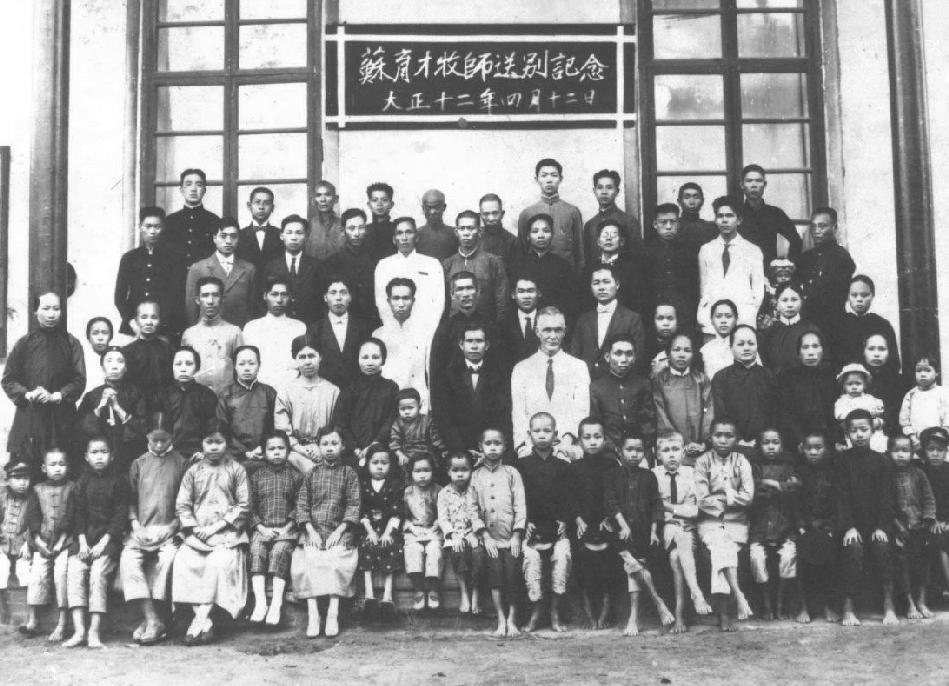
Taiwan Activities: Religion

Figure 1.-- his is the Presbyterian congregation of Changhua, Taiwan, with an English missionary family. Yoy can see the father in the center. His wife is with the women. The children are seated in the front row. All the boys, including the missionary's son, are barefoot. Notice the English boy is wearing a tie. The photo was taken on April 12, 1923 during the Japanese era.
|
|
Taiwan as a result of the different countries influencing the island has a wide range of religious practices. The traditional religions still survive, including Yiguandao and others. Many religions are practiced in China and all the major ones have spead to Taiwan. One interesting aspect of China is that they have never engaged in religious wars as were common in other regions. This tradition has also been followed on Taiwan. Buddhism originated in Indua, but became the most widely professed belief in China. The same is true of Taiwan. Buddhism, Confucianism, and Taoism reflect the Chinese cultural otbit. The Japanese were also Buddhists. They also brought Shintoism with them, but did not insist that local people adopt the religion. As in China, the various religions coexisted in Taiwan, even after the Japanese occupation. Trade and commerce brought Hinduism, Islam, and Christiamity to Taiwan. The Japanese occupation meant that nationalist secret societies like the Boxers did not rise in Taiwan to attack Christians. There are many different Christian churches active as well as the relazted Mormon and Unification Church. Missionaries were active in Taiwan during the Japanese colonial period. Modern Taiwan not only respects traditional faiths but also guarantees religious freedom.
Buddhism
Christinity
Christianity has played a leading role in the 20th-century history of China as well as Taiwan. Both Sun Yat-sen and Chiang Kai-shek became Christians as young adults. The same was true of Lee Teng-hui, Taiwan’s first native-born president. The Dutch first reached Taiwan and with them brought Christianity (1624). Proselytizing began soon after. The Spanish arrived soon after the Dutch and were more interested in proselytizing than the Dutch. Much of the proselytizing was among the aboriginal population. European
proselytizing ceased to exist after the Spain and Netherlands withdrew from Taiwan. The Christian churches now on Taiwan
trace their roots to American and British Protestant missinaries who returned to island (mid-19th century). As many Chinese connected the missionaries with Western conalialism, the misionaries were most sucesful with he aboriginal peoples. Even today many Taiwanese see Christianity as a foreign religion. We have seen varying estimates as to the proportion of Christians in Taiwan, ranging from about to 3-8 percent. Some beleve there is a higher percentage of Christins on mainlnd China, but this is difficylt to assess with any certainty. Among the aborigines on Taiwan however, the proportion of Christians is much higher, perhaps 90 percent.
The Presbyterian Church is single most influential Protestant sect. Presbeterians reached Taiwan via Qijin Island and Danshui (1860s). The Japanese occupation meant that nationalist secret societies like the Boxers did not rise in Taiwan to attack Christians. Churches are prevalent in Taiwan. located in both both mountain villages and major cities. Protetant churches resemble churches in Western countries. Roman Catholic chapels and cathedrals largely imitate classical Chinese architecture. There are many other denominations, including Wesleyans, Baptists and Mormon. Taiwan has also developed some homegrown or Chinese churches.
Comfusianism
Hinduism
Islam
Islamic traders must have reacged Taiwan, but there is little remaining evidence. After the fall of the Ming dynasty, legendary hero called Koxinga (Cheng Cheng-kung) led 25,000 followers from the southern coast of China and seized Taiwan from the Dutch (1661). An unknown number of Muslims are believed yo have come with him. There were minor traces of Islamic pracices on Taiwan when the Japanese seized the island (1895). The Japanese discouraged 'foreign' religious practices. There was no organized Islamic worship until the arrival of refugees from the Communists accompanting Chiang (1949). Perhaps 20,000 Muslims arrived at this time. Thee are five active mosques on Taiwan. Some of the larger Mainland Chinese cities (Peking and Mukden) have mosques exclusively for women, with women ahongs in charge. This has not occurred on Taiwan. Few women go to the mosque, but the ones that do accompany the men. At the mosque they are normally separated by a cloth screen. Women in Chinese women have traditionally enjoyed considerable freedom. And this tends to be the case on Taiwan. There are no harems and no veils. Polygamy as well as divorce are rare. Some religious instruction is given to younger children by their parents in the home. Instruction for older boys and girls is available in the misques, usually during school vacations in the winter and summer. Only the Taipei Mosque has an educational program running year round. Almost all Taiwanese Muslims are descendents of the Muslims which arrived in Taiwan in 1949.
Taoism
HBC

Navigate the Boys' Historical Clothing Web Site:
[Introduction]
[Activities]
[Biographies]
[Chronology]
[Cloth and textiles]
[Clothing styles]
[Countries]
[Topics]
[Bibliographies]
[Contributions]
[FAQs]
[Glossaries]
[Images]
[Links]
[Registration]
[Tools]
[Boys' Clothing Home]
Navigate the Boys' Historical Clothing national pages:
[Return to the Main Taiwan page]
[Return to the Main Asian page]
[Afghanistan]
[Bangladash]
[Bhutan]
[China]
[India]
[Pakistan]
[Sri Lanka]
[Tajikistan]
[Turkmenistan]
[Uzbeckistan]
Created: 3:37 AM 7/11/2015
Last updated: 3:37 AM 7/11/2015



